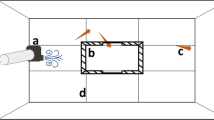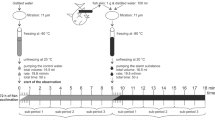Abstract
In cyprinid fish, density of epidermal club cells (i.e. alarm substance cells) has been found to vary between lakes with different predator fauna. Because predators can be labelled with chemical cues from prey, we questioned if club cell density could be controlled indirectly by predators releasing prey cues. In particular, we suspected a possible feedback mechanism between chemical alarm signals and their cellular source. We raised crucian carp singly and in groups of four. For both rearing types, fish were exposed to skin extracts of either conspecifics or brown trout (without club cells), and provided either low or high food rations. Independent of rearing type, condition factor and club cell density increased with food ration size, but no change was found in club cell density following exposure to conspecific alarm signals. However, the density of club cells was found significantly higher for fish raised in groups than for fish raised alone. We conclude that an increased condition factor results in more club cells, but crucian carp may also possess an awareness of conspecific presence, given by higher club cell densities when raised in groups. This increase in club cell density may be induced by unknown chemical factors released by conspecifics.



Similar content being viewed by others


References
Allee WC, Bowen ES, Welty JC, Oesting R (1934) The effect of homotypic conditioning of water on the growth of fishes and chemical studies of the factors involved. J Exp Zool 68:183–213
Allee WC, Finkel AJ, Hoskins WH (1940) The growth of goldfish in homotypically conditioned water: a population study in mass physiology. J Exp Zool 84:417–443
Atema J (1971) Structures and functions of the sense of taste in the catfish (Ictalurus natalis). Brain Behav Evol 4:273–294
Brönmark C, Miner JG (1992) Predator-induced phenotypic change in body morphology in crucian carp. Science 258:1348–1350
Brönmark C, Pettersson LB (1994) Chemical cues from piscivores induce a change in morphology in crucian carp. Oikos 70:396–402
Chivers DP, Wisenden BD, Hindman CJ, Michalak T, Kusch RC, Kaminskyj SW, Jack KL, Ferrari MCO, Pollock RJ, Halbgewachs CF, Pollock MS, Alemadi S, James CT, Savaloja RK, Goater CP, Corwin A, Mirza RS, Kiesecker JM, Brown GE, Adrian JC, Krone PH, Blaustein AR, Mathis A (2007) Epidermal ‘alarm substance’ cells of fishes maintained by non-alarm functions: possible defence against pathogens, parasites and UVB radiation. Proc Biol Sci 274:2611–2619
Chivers DP, Zhao X, Brown GE, Marchant TA, Ferrari MCO (2008) Predator-induced changes in morphology of a prey fish: the effects of food level and temporal frequency of predation risk. Evol Ecol 22:561–574
Gomahr A, Palzenberger M, Kotraschal K (1992) Density and distribution of external taste-buds in cyprinids. Environ Biol Fish 33:125–134
Harvell CD (1990) The ecology and evolution of inducible defences. Q Rev Biol 65:323–340
Hugie DM (1989) An intraspecific approach to the evolution of chemical alarm signalling in the Ostariophysi. MSc thesis, University of Saskatchewan, Saskatoon
Karlson P, Lüscher M (1959) “Pheromones”: a new term for a class of biological active substances. Nature 183:55–56
Lawrence BJ, Smith RJF (1989) Behavioral response of solitary fathead minnows, Pimephales promelas, to alarm substance. J Chem Ecol 15:209–219
Mathis A, Smith RJF (1993a) Chemical labeling of northern pike (Esox lucius) by the alarm pheromone of fathead minnows (Pimephales promelas). J Chem Ecol 19:1967–1979
Mathis A, Smith RJF (1993b) Fathead minnows, Pimephales promelas, learn to recognize northern pike, Esox lucius, as predators on the basis of chemical stimuli from minnows in the pikes diet. Anim Behav 46:645–656
Nash RDM, Valencia AH, Geffen AJ (2006) The origin of Fulton’s condition factor—setting the record straight. Fisheries 31:236–238
Pfeiffer W (1960) Über die Schreckreaktion bei Fischen und die Herkunft des Schreckstoffes. Z Vgl Physiol 43:578–614
Pfeiffer W (1962) The fright reaction of fish. Biol Rev 37:495–511
Pfeiffer W (1974) Pheromones in fish and amphibia. In: Birch MC (ed) Pheromones. North Holland, Amsterdam, pp 269–296
Pfeiffer W (1977) The distribution of fright reaction and alarm substance cells in fishes. Copeia 1977:653–665
Pfeiffer W, Sasse D, Arnold M (1971) The alarm substance cells of Phoxinus phoxinus and Morulius Chrysophakedion (Cyprinidae, Ostariophysi, Pisces). Histochemical and electron microscopical study. Z Zellforsch Mikrosk Anat 118:203–213
Reutter K, Pfeiffer W (1973) Fluoreszenzmikroskopischer Nachweis des Schreckstoffes in den Schreckstoffzellen der Elritze. Phoxinus phoxinus (L.) (Cyprinidae, Ostariophysi, Pisces). J Comp Physiol 82:411–418
Ricker WE (1975) Computation and interpretation of biological statistics of fish populations, vol 191. Bulletin of the Fisheries Research Board of Canada, pp 1–382
Siegel S, Castellan NJ (1988) Nonparametric statistics for the behavioral sciences. McGraw-Hill, New York
Smith RJF (1973) Testosterone eliminates alarm substance in the male fathead minnows. Can J Zool 51:875–876
Smith RJF (1976a) Seasonal loss of alarm substance cells in North American cyprinoid fishes and its relation to abrasive spawning behaviour. Can J Zool 54:1172–1182
Smith RJF (1976b) Male fathead minnows (Pimephales promelas Rafinesque) retain their fright reaction to alarm substances during the breeding season. Can J Zool 54:2230–2231
Smith RJF (1992) Alarm signals in fishes. Rev Fish Biol Fish 2:33–63
Snedecor GW, Cochran WG (1980) Statistical methods. The Iowa State University Press, Ames
Sokal RR, Rohlf FJ (1987) Introduction to biostatistics. WH Freeman and Co, San Francisco
Stabell OB, Lwin MS (1997) Predator-induced phenotypic changes in crucian carp are caused by chemical signals from conspecifics. Environ Biol Fish 49:145–149
Strüssmann CA, Nin F, Takashima F (1994) Microscale variation in epidermal thickness, distribution, and size of mucus and alarm substance cells in the skin of juvenile fancy carp (Cyprinus carpio). Copeia 1994:956–961
Tollrian R, Harvell CD (1999) The ecology and evolution of inducible defences. Princeton University Press, Princeton
von Frisch K (1938) Zur Psychologie des Fisch-Schwarmes. Naturwissenschaften 29:321–333
von Frisch K (1941) Über einen Schreckstoff der Fischhaut und seine biologishe Bedeutung. Z Vgl Physiol 29:46–145
Whitear M, Mittal AK (1983) Fine-structure of the club cells in the skin of ostariophysan fish. Z Mikrosk Anat Forsc 97:141–157
Wilson EO, Bossert WH (1963) Chemical communication among animals. In: Pincus G (ed) Recent progress in hormone research. Academic Press, New York, pp 673–716
Wisenden BD, Smith RJF (1997) The effect of physical condition and shoalmate familiarity on proliferation of alarm substance cells in the epidermis of fathead minnows. J Fish Biol 50:799–808
Wisenden BD, Smith RJF (1998) A re-evaluation of the effect of shoalmate familiarity on the proliferation of alarm substance cells in ostariophysan fishes. J Fish Biol 53:841–846
Acknowledgments
This work was supported by the Research Council of Norway, through grant no. 159213/V40. The authors declare that they have no conflict of interest. All handling and rearing of fish was carried out in accordance with the Norwegian national guidelines for treatment of animals. We want to thank Anna C. Faeravaag for her support in capturing fish and preparing tissue samples for histology, and Mette Tellefsen and her colleagues in the Pathology Group at Sørlandet Hospital HF who gave valuable support in the routine histology work. We are also indebted to Kirsten Bjørkestøl for her help in statistical calculations, James R. Mitchell for English corrections, and two anonymous reviewers for valuable comments to improve the paper.
Author information
Authors and Affiliations
Corresponding author
Rights and permissions
About this article
Cite this article
Stabell, O.B., Vegusdal, A. Socializing makes thick-skinned individuals: on the density of epidermal alarm substance cells in cyprinid fish, the crucian carp (Carassius carassius). J Comp Physiol A 196, 639–647 (2010). https://doi.org/10.1007/s00359-010-0550-4
Received:
Revised:
Accepted:
Published:
Issue Date:
DOI: https://doi.org/10.1007/s00359-010-0550-4


